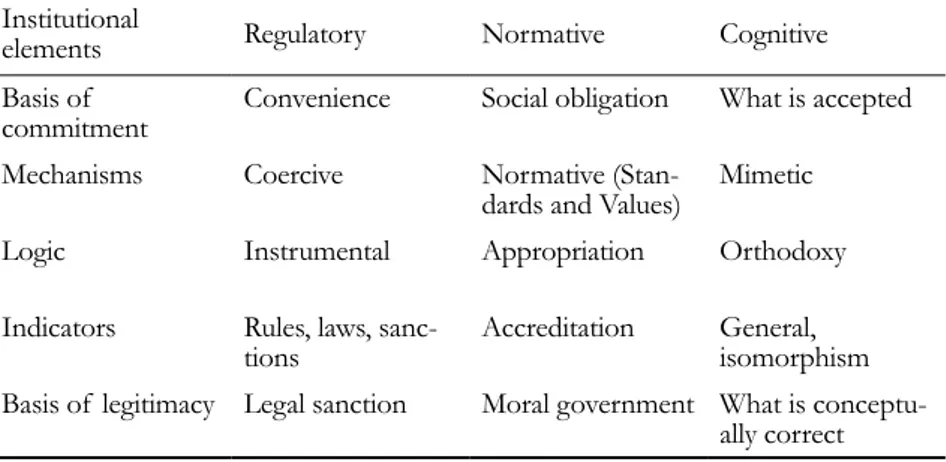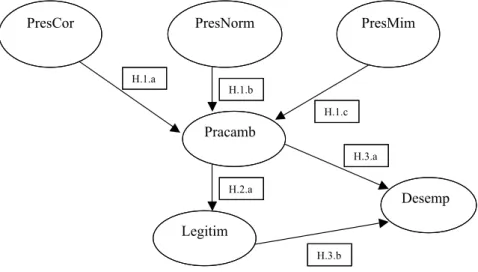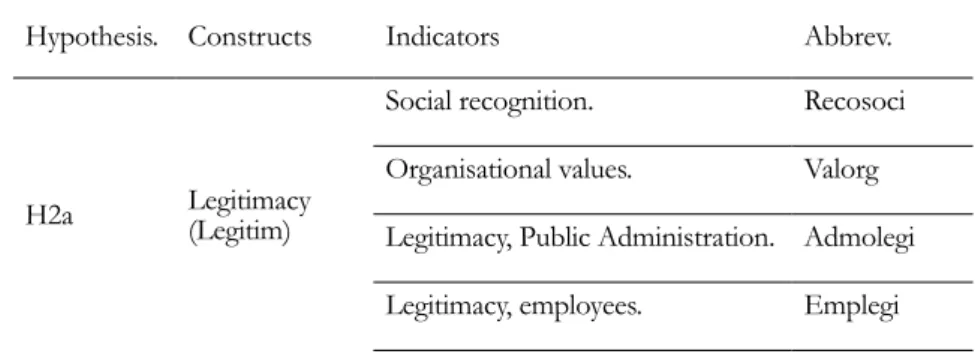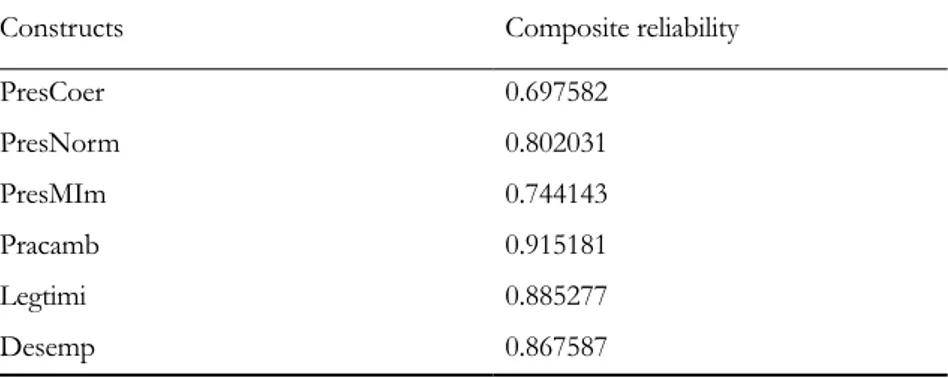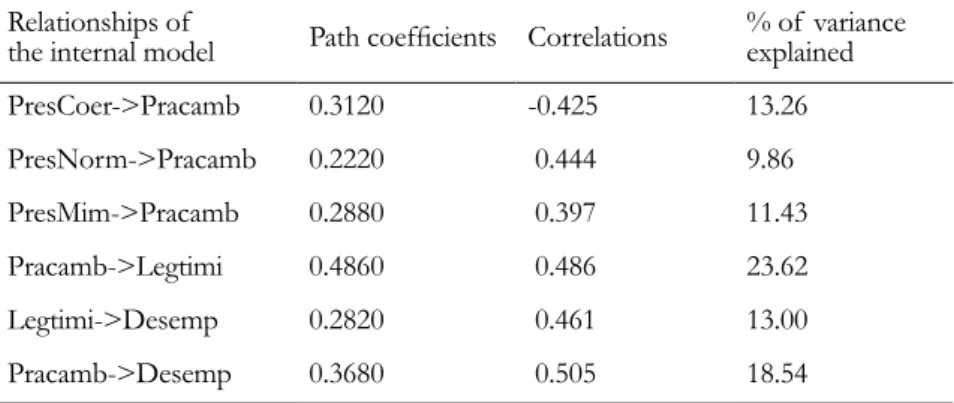24
www.ejthr.com Research
EJTHRTourism
European Journal of
Tourism, Hospitality and Recreation
Research
EJTHRTourism
European Journal of
Tourism, Hospitality and Recreation
© 2010 Polytechnic Institute of Leiria. All rights reserved Printed in Portugal
aN iNSTiTuTiONal aPPrOaCH
TO THE ENvirONMENTal
MaNaGEMENT SYSTEMS Of
GOlf COurSES iN aNdaluSia
1alfonso vargas-Sánchez
francisco riquel-ligero University of Huelva, Spain
AbstrAct: In many tourist destinations, such as Andalusia in Spain, the number of golf
courses has increased exponentially, which has generated a public debate about how to recon-cile economic development and respect for the natural environment. This paper analyzes its highly institutionalized context - and the main practices that derive from it - and test empiri-cally, in a sample of golf courses located in Andalusia, the relationships between these practices with its corresponding coercive, normative and mimetic mechanisms. Finally, its relationship with the performance of these organizations is established, testing if a direct or indirect re-lationship, through the search for legitimacy, exists, as suggested by the Institutional Theory.
Keywords: Institutional Theory, golf, tourism, environmental management.
resumen: En muchos destinos turísticos, tales como Andalucía, en España, el número de
campos de golf se ha incrementado exponencialmente, lo que ha generado un debate público sobre cómo conciliar el desarrollo económico y el respeto por el medio ambiente natural. En este estudio se analiza su contexto altamente institucionalizado - y las principales prácticas que derivan de ello - y se pone a prueba empíricamente, en una muestra de campos de golf situados en Andalucía, las relaciones entre estas prácticas con sus correspondientes mecanis-mos coercitivos, normativos y miméticos. Finalmente, su relación con el desempeño de estas organizaciones se establece, probando si existe una relación directa o indirecta, a través de la búsqueda de legitimidad, como lo sugiere la Teoría Institucional.
Palabras clave: Teoría Institucional, golf, turismo, gestión ambiental. INTRoDUCTIoN
The practice of golf is a phenomenon that goes beyond the mere sport, it carries implications of great significance for tourism. It has risen to an entire tourism industry revolving around golf, and Andalusia has become the leading region of Spain in the reception of tourists of this type, with the consequent increase in the number of golf courses.
However, there is an open debate in society on the environmental impact of this type of installation. This debate has led to a series of
Alfonso Vargas-Sánchez, PhD, is a full-time professor of strategic management at the
Spanish University of Huelva. He heads its research group on “Innovation and Development Strategies in Business Tourism” (GEIDETUR). Francisco Riquel-Ligero is an associate lec-turer of business administration at the University of Huelva in Spain, where he is an active member of the GEIDETUR.
actions being undertaken, in most cases imposed by legal regulation, aimed at reducing the negative effects that golf courses can have on the natural environment. Consequently, we have opted to take Institu-tional Theory as our reference framework.
The great majority of theoretical institutionalists agreed that the three pillars supporting this theory are the regulatory, normative and cognitive approaches (Table 1).
Table 1. Differences of emphasis of the three institutional pillars
Institutional
elements Regulatory Normative Cognitive Basis of
commitment Convenience Social obligation What is accepted Mechanisms Coercive Normative
(Stan-dards and Values) Mimetic Logic Instrumental Appropriation orthodoxy Indicators Rules, laws,
sanc-tions Accreditation General,isomorphism Basis of legitimacy Legal sanction Moral government What is
conceptu-ally correct
Source: Scott, 1995.
The regulatory institutionalists interpret legitimacy as conformity with standards. Thus legitimate organisations will be those that act in accordance with the legal requirements, carrying out actions rationally and subject to a legal, rational and consciously constructed order. The agents act in their environment in response to diverse restrictions and incentives that they believe will serve their own interests.
The normative conception considers legitimacy as moral obligation, which goes beyond the merely legal requirements. It is argued that nor-mative controls will be more interiorised than regulatory controls, and compliance with those controls will bring both intrinsic and extrinsic rewards. Actions carried out are rooted in their social context and are orientated by the moral dimension provided by obligations and rela-tionships with others, in each situation (Navarro & Ruiz, 1997).
Lastly, in the cognitive pillar it is stated that organisations seek le-gitimacy by adopting structures and behaviours of reference, already accepted as correct, that are designated “socially-constructed accepta-tions” (Navarro & Ruiz, 1997). organisations operate in accordance with “rational myths”, which are the institutionalised beliefs or rules of the game (Scott, 1995).
RESEARCH MoDEL
The research model proposed is based on the configuration of the institutional context of the golf courses of Andalusia. The different systems that we have described previously translate to the three insti-tutional mechanisms (normative, coercive and mimetic) that will exert pressure on their environmental practices. Therefore, the proposed research model is presented in Figure 1.
Figure 1. Graphical representation of the model Source: Authors’ own compilation.
PresNorm = Normative Pressure. Prescor = Coercive Pressure. PresMin = Mimetic Pressure.
Pracamb = Execution of environmental practices. Desemp = organisational performance/returns. Legitim = Legitimacy.
The following research hypotheses are put forward:
H1a: Coercive pressure produced by the laws and other regulations applicable to the activities carried out in the golf courses of Andalusia have a positive influence on the adoption of sustainable environmen-tal practices by these organisations. (+)
H1b: The acceptance of values and standards that originate from the normative pressures applicable in the context of the golf courses in Andalusia have a positive influence on the adoption of sustainable environmental practices by these organisations. (+)
H1c: The imitation of environmental practices employed by other organisations perceived as successful by the golf courses in Andalusia has a positive influence on the adoption of sustainable environmental practices by these organisations. (+)
H2a: The implementation of environmental practices by the golf courses in Andalusia is principally motivated by the search for social legitimacy, more than by the increase of business performance or re-turns. (+)
H3a: The implementation of responsible environmental manage-ment practices by the golf courses in Andalusia has a positive influence on the business performance of these organisations. (+)
H3b: A positive direct relationship exists between the social legiti-macy sought by the golf courses in Andalusia and their business per-formance or returns. (+)
From the preceding hypotheses, it can be inferred that our model aims to measure the degree of influence that the mechanisms of in-stitutional pressure (Scott, 1995; DiMaggio & Powell, 1983; North, 1990; Berger & Luckman, 1967; D´Andrade, 1984) have on the em-ployment of sustainable environmental practices by the golf courses in Andalusia. In addition, we aim to corroborate the propositions of the classic institutionalists (Meyer & Rowan, 1977), in the sense that the final objective of practices of this type is more to gain legitimacy and social acceptance than to increase economic efficiency or organi-sational performance/returns.
METHoDoLoGY AND SAMPLE
The instrument of measurement utilised to obtain the data was a structured questionnaire directed to the green keepers and/or man-agers of the golf courses of the Autonomous Region of Andalusia, since these are believed to be the individuals who have the most direct information on the topics studied.
A first version of the questionnaire was tested by several faculty members, with experience in this type of research, and managers of golf courses. our objective was to ensure the validity of content of the instrument of measurement. once the questionnaire had been sent, and after waiting one week, we interviewed these initial recipi-ents to analyse their suggestions, which were incorporated in the de-finitive questionnaire.
Having thus validated the questionnaire, we were then ready to apply it to the population being studied, that is, to the population consisting of the 96 golf courses in Andalusia that were in active operation dur-ing the year 2009. In continuation (Table 2), we present the principal characteristics of the sample.
Table 2. Technical specifications of the sampling
Research field Golf courses located in the Autono-mous Region of Andalusia Geographic location Andalusia
Methodology Structured questionnaire Universe 96 golf courses in Andalusia Size of the sample Sample = universe, 96 golf courses Valid responses 31 (32.29% of response rate)
Sampling error 7.42%
Level of confidence 95%, p = q = 0.5; Z = 1.96
Period of data collection Pretest: September 2008. First mailing: December 2008. First re-mailing: Janu-ary 2009. Second re-mailing: FebruJanu-ary 2009. Treatment of data: February and March 2009.
The scale utilised to measure the key factors of the research mod-el is a Likert scale of five points. For the three pressure mechanisms argued under the Institutional Theory the type of measurement used has been utilised before, in the studies of DiMaggio and Powell (1991), Kostova and Roth (2002), and Llanas (2005). For the performance of environmental practices we have taken the indicators designed by Romero et. al. (2005) as the basis. The measurement of legitimacy has been made based on Deephouse (1996). Lastly, we utilised the scale proposed by Powell and Dent-Micallef (1997) to measure the organi-sational performance, utilising the respondents’ perceptions of their own organisation’s performance in comparison with its competitors.
Table 3. Latent variables of the model and indicators
Hypothesis. Constructs Indicators Abbrev.
H2a Legitimacy(Legitim)
Social recognition. Recosoci organisational values. Valorg Legitimacy, Public Administration. Admolegi Legitimacy, employees. Emplegi
Legitimacy, citizens. Ciulegi Legitimacy, communications
media. Maslegi
Legitimacy, customers. Clielegi Legitimacy, suppliers. Provlegi Legitimacy, associations
of ecologists Asoclegi
Legitimacy, professional
associations. Proflegi
Legitimacy, business sector. Sectlegi Relationships with pressure
groups. Relagrup
H1a Coercive pres-sure (Prescor)
Knowledge of laws. Conoley Compliance with laws. Cumpley Regulatory authorities. orgregul Existence of agreements. Exacuerd
H1b Normative pressure (Presnor)
Moral obligation. obligmor Congruence with values of
the context. Congrval
Social norms. Normsoci
H1c Mimetic pres-sure (Presmim)
Knowledge from experience. Conoexp Models to follow Modelseg Imitation practices. Imiprac Knowledge of successful experience. Conoexit H3a Environmental management practices (Pracamb) Number of environmental proposals. Numprop
Proposals put into practice. Propract
(cont.)
Proposal achieves objectives. Probjet Cost of environmental actions. Costemed Number of environmental legal
proceedings. Expedmed
Employees in environmental
train-ing activities. Emplefor
Hours of environmental training
activities. Horafor
Awarded environmental
certification. Provcert
Purchases from suppliers
with environmental certification. Compcert Expenditure on disseminating
environmental achievements. Diflogro Expenditure on campaigns
to increase awareness. Campconc
H3b
Business performance or returns (Desemp)
Economic conditions 2007. Condeco Financial result 2007. Rtdoeco
Returns 2007. Rentbil
Number of Green Fees 2007. Numgren Market share 2007. Cuotame Economic conditions 2003-2007. Condec03 Financial result 2003-2007. Rtdoec03 Returns 2003-2007. Rentb03 Number of Green Fees
2003-2007. Num03
Market share 2003-2007. Cuota03
The scales were reviewed utilising factorial analysis, with the ob-ject of determining their uni-dimensionality. In relation to the type of indicator selected, in all cases the indicators have been of the re-flective type.
ANALYSIS oF DATA USING PLS
The PLS (Partial Least Squares) technique has been utilised for the analysis of the data. This technique can be considered appropriate in our case for two main reasons. First, as a result of the procedure of segmentation of complex models, the PLS approach can work with small sample sizes (Barclay et al., 1992), as in our case. Second, accord-ing to Sellaccord-ing (1995), the use of PLS should be considered in studies of the exploratory nature.
The graphic representation of the structural model appears in fig-ure I. Having represented and defined the variables, a PLS model has to be analysed and interpreted in two steps, in which the measurement model and the structural model are considered.
Analysis of the measurement model
In this step we determine whether the theoretical concepts are meas-ured correctly by the variables observed; for this their validity and reli-ability are studied. In a PLS model the individual relireli-ability of the item, the internal consistency and the convergent and discriminant validity are analysed (Chin, 1998).
The individual reliability of each item for constructs with reflec-tive indicators is evaluated by the PLS model by examining the load-ing, or simple correlation, of each indicator with the construct that it is intended to measure. The value of the standardized loadings must be equal to or greater than 0.50 according to Falker and Miller (1992). In the scales employed, the majority of the indicators present loadings higher than 0.50; in particular, and after successive clearings, we are left with 27 items, out of a total of 44 that comprised the initial scale.
Table 4. Composite reliability of the constructs of the model
Constructs Composite reliability
PresCoer 0.697582 PresNorm 0.802031 PresMIm 0.744143 Pracamb 0.915181 Legtimi 0.885277 Desemp 0.867587
The reliability of a construct allows us to check the internal con-sistency of all the indicators when measuring the concept; in other words, an evaluation is made of how rigorously the manifest variables are measuring the same latent variable. To measure this parameter
we must look at the composite reliability, given the advantages that it presents over the Cronbach’s Alpha. For this we follow Nunnally (1988), who suggests 0.7 as a modest level for the reliability in early stages of research, and a stricter 0.8 for basic research. Table 4 gives the values of the composite reliability obtained, for the reflective constructs that comprise the model proposed.
It can be seen that all the constructs have a composite reliability higher than or practically equal to 0.7.
The convergent validity is analysed by the average variance extract-ed (AVE), which gives the amount of variance that a construct obtains from its indicators in relation to the amount of variance due to the measurement error. For this, Fornell and Lacker (1981) recommend values higher than 0.5, since this level guarantees that at least 50% of the variance of the construct is due to its indicators. Table 5 presents the values of the AVE obtained in the research model proposed.
As can be observed, all the constructs of the research model pro-posed meet the condition recommended by Fornell and Lacker (1981); therefore it is accepted that the constructs possess convergent validity.
Table 5. Convergent validity of the constructs of the model
Constructs AVE PresCoer 0.537966 PresNorm 0.579547 PresMIm 0.593380 Pracamb 0.576204 Legtimi 0.609760 Desemp 0.505700
To evaluate the discriminant validity we check whether the aver-age variance extracted (AVE) of the construct is greater than the square of the correlations between that construct and the rest that make up the research model (Fornell & Lacker, 1981), which indicates that one construct is different from any other. To make the procedure of cal-culation more practical, we perform the inverse procedure, that is, to determine the discriminant validity of a construct the square root of AVE is calculated; the AVE has previously been calculated by running the data on the Visual-PLS software; the value must be higher than the correlations presented with the rest of the constructs. These values are given in the Table 6, in which the elements of the diagonal corre-spond to the square roots of the AVEs.
Table 6. Discriminant validity
Constructs PresCoer Pres-Norm PresMIm Pracamb Legtimi Desemp PresCoer 0.733 PresNorm -0.382 0.761 PresMIm -0.097 0.357 0.770 Pracamb -0.425 0.444 0.397 0.759 Legtimi -0.312 0.633 0.411 0.486 0.780 Desemp -0.464 0.207 0.135 0.505 0.461 0.711
As can be observed, all the constructs meet the condition argued by Fornell and Lacker (1981); therefore we can state that the constructs have discriminant validity.
Analysis of the structural model
Table 7 reflects the path coefficients between the different con-structs, which tell us, in each case, the strength of the relationship es-tablished between two constructs:
Table 7. Path coefficients, correlations and variance explained
Relationships of
the internal model Path coefficients Correlations % of varianceexplained PresCoer->Pracamb 0.3120 -0.425 13.26 PresNorm->Pracamb 0.2220 0.444 9.86 PresMim->Pracamb 0.2880 0.397 11.43 Pracamb->Legtimi 0.4860 0.486 23.62 Legtimi->Desemp 0.2820 0.461 13.00 Pracamb->Desemp 0.3680 0.505 18.54
As can be observed in Table 7, all the path coefficients meet the condition proposed by Chin (1998), being above 0.2.
The predictive power of the model that we have put forward can
be analysed utilising the value of the variance explained (R2) for the
dependent latent variables (Chin, 1998; Falk & Miller, 1992; Leal & Roldán, 2001). Falk and Miller (1992) stipulate values that are equal to or larger than 0.1 as adequate for the variance explained. In our case,
as reflected Table 8, we can conclude that the model presents an ad-equate predictive power.
Table 8. Variance explained of the dependent variables
Endogenous constructs R2
Pracamb 0.345
Legitmi 0.236
Desemp 0.315
In respect of the stability of the estimations offered and accord-ing to the propositions argued by Barclay et al. (1995), Tenenhaus et al. (2005) and Henseler et al. (2009), we consider appropriate to com-plement the analysis of the structural model estimated with the PLS
technique, by means of the cross-validated redundancy index (q2) or the
Stone-Geisser test (Stone, 1974; Geisser, 1975). In our case the values
of q2 are slightly higher than zero, as shown in Table 9; this indicates
that the model has some predictive capacity or relevance, albeit weak.
Table 9. Stone-Geisser test for the latent variables
Endogenous constructs q2
Pracamb 0.005
Legitmi 0.002
Desemp 0.003
In any case, the values presented by q2 in our work are not
nega-tive, which would have indicated that the model lacked any predictive power (Henseler, 2009). We agree, however, with what Barclay et al. (1995) state. They argue that the objective of the PLS analysis is to
explain the variance in a sense of regression and thus R2 and the level
of the path coefficients are measures sufficient and indicative of how well the model performs. In our cases acceptable levels in both meas-ures are obtained, so we can conclude that the model does have pre-dictive capacity.
TESTING oF HYPoTHESES
Subsequent to this checking, we have executed a Bootstrap anal-ysis in PLS to utilise a Student-T distribution of two tails, with n-1 degrees of freedom, n being the number of subsamples analysed (in
our case 500), to determine that the relationships (hypotheses) are statistically significant.
The following figure shows the ß coefficients and the Student-T tests (in parentheses in Figure 2) of all the relationships between the constructs of our model.
Figure 2. Model with the results of testing the hypotheses
If we take as reference the levels of acceptance commonly argued in the scientific literature for this type of PLS technique, we can state that the hypotheses H1a, H1c and H2a would be accepted and their testing would be positive. Similarly, the hypotheses H1b, H3a and H4a would be rejected because their Student-T test values do not exceed the minimum level required of 1.96 (or alternatively we would have to lower the level of significance demanded).
CoNCLUSIoNS
The object of the present work is to analyse and study the impact of the corresponding institutional context on the golf courses of An-dalusia. A series of conclusions can be drawn from this analysis, with implications for the management of organisations of this type.
First we can state that the golf courses of Andalusia coexist with a highly institutionalised environment, in which we can differentiate the
classic mechanisms of pressure and isomorphism developed according to Institutional Theory and defended by authors such as Meyer and Rowan (1977), Scott (1995) and DiMaggio and Powell (1983). Thus, we can distinguish a coercive mechanism that is reflected in the broad legal tradition regulating the activities of these organisations; similarly we have been able to identify a mimetic mechanism arising out of the experiences considered successful in environmental matters; and lastly there is a normative mechanism that arises from the various initiatives of professional associations of this field in environmental matters.
From this institutional context, which we have identified and de-fined, we can conclude, in function of the data of composite relia-bility that we have obtained, that all the constructs considered in the present study have a fairly acceptable internal consistency. Similarly, we can state that at least 50% of the variance of all the constructs is due to their indicators; therefore convergent validity is another of the characteristics to be noted, particularly in respect of the constructs that form the institutional context.
We can state that the mechanism that has the greatest incidence on the development of environmental management practices by these organisations is coercive pressure, followed by mimetic pressure and, in third place, normative pressure. This proposition is motivated by the great diversity of standards that exist in relation to the activities of golf course management, and their relationship to the natural en-vironment, and especially by the approval of Decree 43/2008 that regulates the establishment and functioning of golf courses in An-dalusia, with many environmental implications.
Another of the conclusions that needs to be emphasised refers to the importance for these golf course of the concept of legitimacy, understood broadly as social acceptance. It has been demonstrated in the study that the principal motivation for implementing practices of environmental protection is the achievement of social legitimacy, even more than the improvement of financial performance and returns. Moreover, those managers interviewed at these golf courses do not believe that a greater legitimacy necessarily generates better returns for them. They are similarly sceptical that putting environmental policies into practice represents a better organisational performance for them.
The preceding statement strengthens the importance for the golf courses of being respectful of the natural environment, since this confers social acceptance to them and, therefore, brings clients and resources that ensure their survival.
our aim with this study is to contribute to the studies termed “en-vironmental or green institutionalism”, but from a perspective of or-ganisations related to tourism, and we believe this study provides ad-ditional knowledge to this field of research.
REFERENCES
Barclay, D., Higgins, C., & Thompson, R. (1995). The Partial Least Square (PLS). Approach to causal modelling: Personal computer adoption and use as an illustration. Technology Studies, 2(2), 285-309.
Barclay, D., Higgins, C., & Thompson, R. (1995). The Partial Least Square (PLS). Approach to causal modelling: Personal computer adoption and use as an illustration. Technology Studies, 2(2), 285-309.
Berger, P., Luckman T. (1967). La construcción social de la realidad. Buenos Aires: Amorrortu Editores.
Chin, W. (1998). The Partial Least Square Approach to Structural Equa-tion Modeling. In G. A. Marcoulides (Ed.), Modern Methods for Business Research (pp. 295-336). Mahwah, NJ: Lawrence Erlbaum.
D`Andrade, R. G. (1984). Cultural meaning system. Cambridge, UK: Cam-bridge University Press.
Deephouse, D. L. (1996). Does Isomorphism legitimate? Academy of Man-agement Journal, 39(4), 1024-1039.
DiMaggio, P. J., Powell W. W. (1983). The Iron Cage revisited: Institu-tional Isomorphism and Collective RaInstitu-tionality. American Sociological Review, 48, 147-160.
DiMaggio, P.J., Powell W. W. (1991). The new institutionalism in organizational analysis. Chicago: University of Chicago Press.
Falk, R., Miller, N. (1992). A primer soft modelling. Akron: The University of Akron Press.
Fornel, C., Lacker, D. (1981). Evaluating structural equation models with unobservable variables and measurement error: Algebra and statistic. Journal of Marketing Research, 28, February, 39-50.
Geisser, S. (1975). The predictive Sample Reuse Method with applications. J. Am. Stat. Assoc.,70, 320-328.
Henseler, J, Ringle, C., & Sinkovics, R. (2009). The use of partial least square path modelling in international marketing. In Rudolf, I, Sinkovics, R. & Pervez, N. (Eds.), Vol. 20. Advance in International Marketing (pp. 277-319).
Kostova, T., Roth, K. (2002). Adoption o fan organizational practice by subsidiaries of multinational corporations: Institutional and relational effects. Academy of Management Journal, 45, 215-243.
Leal, A., Roldán, J. (2001). Validación de un modelo de implantación de gestión de calidad total y su efecto en los resultados empresariales: un estudio causal predictivo mediante análisis PLS (Partial Least Squares). X International Conference, Eu-ropean Association of Management and Business Economics. Reggio Ca-labria, Italy, 541-555.
Llanas, R. (2005). Un análisis institucional de la implantación de la Agenda Lo-cal 21 por los Ayuntamientos españoles. PhD Dissertation. Granada: University of Granada.
Navarro, J., Ruiz, M. (1997). Teoría Institucional y Teoría de la organiza-ción. Anales de Economía y Administración de Empresas, 5, 135-152.
North, D. (1990). Institutions, Institutional change and economic performance. Po-litical economic of institutions and decisions. Cambridge, UK: Cambridge Univer-sity Press.
Numally, J. (1988). Psychometric Theory. 2ª ed. New York: McGraw-Hill. Pinto, J, Fernández, R., Martínez, L., & Kauffman, G. (2006). Análisis del énfasis en la innovación en la implantación “Middle-up-down” management model: Un estudio evolutivo en las empresas manufactureras del País Vasco - Aspectos metodológicos y empíricos. Estudios Gerenciales, 22 (10), 37-59.
Powell, W., & Dent-Micallef, A. (1997). Information technology as com-petitive advantage: The role of human, Business, and technology resources. Strategic Management Journal, 18(5), 375-405.
Romero, q. et al. (2005). Modelo para la evaluación del comportamiento medioam-biental: una aplicación a los campos de golf españoles. PhD Dissertation. Las Palmas de Gran Canaria: University of Las Palmas de Gran Canaria.
Scott, W. R. (1995). Institutions and organizations. Sage Publications. Selling, N. (1995). Partial least square modelling in research on educational achievement. In W. Bos & R. H. Lehmann: Reflections on Educational Achieve-ment, Papers in Honour of T. Neville Postlehwaite (pp. 256-267).
Stone, M. (1974). Cross-Validatory choice and assessment of statistical predictions. Journal of Royal Statistical Society, 2(36), 111-147.
Tenenhaus, M., Vinzi, V., Chatelin, J., & Lauro, C. (2005). PLS path mod-elling. Computational Statistics & Data Analysis, 48(1), 159-205.
